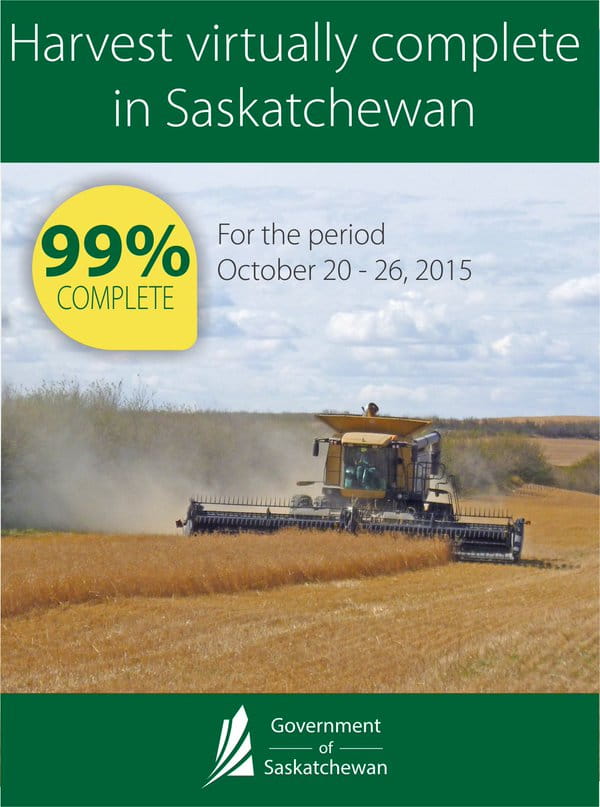Released on October 29, 2015
Harvest has essentially wrapped up in the province as 99 per cent of the crop is now in the bin, according to Saskatchewan Agriculture’s Weekly Crop Report. There are some crops such as flax and oats left to be combined when weather and time permits. Harvest was challenging for producers due to frequent rainfall, delayed maturity and secondary growth of weeds.Crop quality remains an issue for some areas, with the majority rated either close to or below the 10 year average.
Rainfall throughout harvest caused sprouting, bleaching and staining in many cereal and pulse crops.
Yields vary throughout the province and are reported as average in most cases. Yields for hard red spring wheat are reported as 37 bushels per acre, durum 38 bushels per acre, oats 85 bushels per acre, barley 59 bushels per acre, canola 34 bushels per acre, peas 31 bushels per acre and lentils 1,293 lb. per acre.
Average hay yields on dry land are reported as 1.1 tons per acre for alfalfa and alfalfa/brome hay, 1.0 ton per acre for other tame hay, 0.9 tons per acre for wild hay and 1.7 tons per acre for greenfeed. On irrigated land, the estimated average hay yields are 3.0 tons per acre for alfalfa hay and other tame hay, 3.5 tons per acre for alfalfa/brome hay and 4.0 tons per acre for greenfeed. Cattle producers have indicated that they have adequate winter feed supplies.

The number of acres seeded into winter cereals is about average in most areas. However, due to a late harvest, wet conditions in some areas and dry soil conditions in other areas, the number of acres seeded has slightly decreased in the southeastern, east-central and west-central regions compared to the previous year. Acres seeded to fall rye have increased in the southeast.
Rainfall this past week ranged from trace amounts to more than an inch in some southern areas. Heading into winter, topsoil moisture conditions are rated as nine per cent surplus, 85 per cent adequate and six per cent short. Hay land and pasture topsoil moisture is rated as two per cent surplus, 84 per cent adequate and 14 per cent short. The east-central and northeast regions are reporting excess moisture in many fields.
Farmers are busy completing fall work, bringing cattle home from pastures and hauling bales.
You can follow the 2016 Crop Report on Twitter at @SKAgriculture.
-30-
For more information, contact:
Shannon Friesen
Agriculture
Moose Jaw
Phone: 306-694-3592
Email: shannon.friesen@gov.sk.ca
